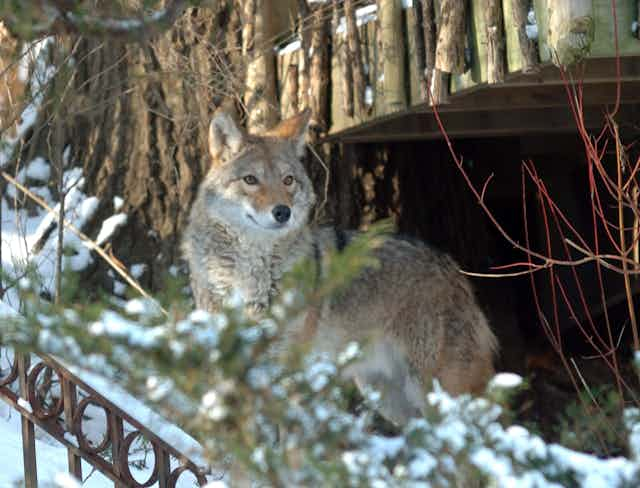It’s a common story in many North American cities: a coyote is seen on an urban trail, sports field or schoolyard. Members of the public panic, insisting that the proximity or frequency of these sightings mean the coyote has become bold, aggressive or habituated. Public authorities are pressured to take action and, since relocation is often unfeasible or not permitted, trappers are called in and coyotes are killed, often generating substantial public outcry.
If food resources — garbage, pet food, bird feeders — and community behaviours, like intentional feeding or not wildlife proofing property, remain unchanged, it’s only a matter of time before other animals move in to fill the niche and the cycle begins again.
It’s past time to accept that lethal methods and relocation are neither effective, sustainable nor humane approaches to human-wildlife conflicts. We need better solutions for coexistence.
The question of how to coexist with wildlife in urban environments led to a research collaboration between me, an animal geographer at Queen’s University, and Coyote Watch Canada (CWC). Part of this has involved assessing nonlethal approaches to coyote management, including the use of aversion conditioning, also termed “humane hazing.” Aversion conditioning uses deterrents — such as gestures, voice or a noisemaker — during encounters, safely compelling wildlife to move away from humans.
Aversion conditioning
Coyote Watch Canada has been working to change the narrative and outcomes of human-coyote interactions. As a recent example, when concerned parents and teachers reported a coyote frequenting a schoolyard in London, Ont., in May 2018, an investigation revealed the coyote was drawn to the site by the abundant groundhog population.
After several deployments of aversion conditioning by members of the CWC Canid Response Team (a team of trained volunteers who implement on-the-ground responses such as investigation, rescue and conflict resolution) and trained school staff, the coyote stopped frequenting the schoolyard, and there have been no issues since.
This story has two key take-aways. First, coyote behaviour and motivation is often misinterpreted — a situation not helped by pervasive media sensationalism. For instance, although coyotes are often presented as a safety threat, data demonstrate that your chances of being bitten by a coyote are infinitesimal compared with the risks of living around other animals, especially domestic dogs, and that nearly all coyote bites are the result of human feeding leading to food-conditioned behaviour. Second, aversion conditioning is a safe and effective nonlethal tool to mitigate coyote concerns in urban areas.
Although aversion conditioning is increasingly advocated by many organizations and communities, key questions remain, including: How should it be implemented, and by whom? What factors influence its efficacy and outcomes? What results are we trying to achieve, and how can they be measured?
Researchers and communities are assessing hazing as a tool for urban coyote management.
Members of CWC’s Canid Response Team had noted that many of the assumptions surrounding aversion conditioning and coyote behaviour lack scientific backing and did not align with their field experiences. In 2019, CWC organized a workshop on aversion conditioning, culminating in a set of best practices that were published in the journal Human Wildlife Interactions.
The need for best practices
A central question is how aversion conditioning is implemented. For instance, some communities and wildlife managers have suggested organizing members of the public into hazing crews. But these crews may not have sufficient training to assess circumstances and effectively deploy the methodology. This risks validating anti-coyote vigilantism.
Similarly, hazing programs that use dogs or projectiles, such as chalk balls, are questionable. Such strategies pose serious animal welfare concerns. And if aversion conditioning is premised on coyotes associating human encounters with a negative experience, being harassed by a dog or shot from a distance does not foster this learning.
Furthermore, aversion conditioning is often implemented and assessed as a lone conflict-mitigation measure, without managing human behaviours and food attractants. Instead, aversion conditioning should be implemented as part of a community-wide wildlife coexistence framework that focuses on prevention, investigation, enforcement (e.g. dog leashing and wildlife feeding bylaws) and education.
This involves dispelling myths, for instance letting people know that coyotes do not stalk people, but that they may shadow or escort dogs near a den to make sure they leave the area and are no longer a threat. In fact, off-leash dogs approaching den sites are one of the key sources of dog-coyote conflict. Some jurisdictions, such Presidio, Calif., and Guelph, Ont., have chosen to temporarily restrict dogs from coyote denning areas.
Finally, there is a commonly held assumption that if an animal has become “habituated” to humans (no longer afraid of them), the only option is lethal removal. But the behaviour of individual coyotes that are very persistent in accessing resources and willing to tolerate human proximity can still be effectively reshaped.
Along with managing anthropogenic food attractants, like intentional feeding, pet food, compost, fruit trees or bird feeders, our team has been successful in re-educating coyotes through aversion conditioning to mitigate conflict scenarios.
Paths to coexistence
Living alongside wildlife, especially larger animals, in cities is complex and multifaceted, as diverse public understandings, values and preferences intersect with animals. Mainstream wildlife management has for too long been steeped in a paradigm of instrumental use, human convenience and animal expendability. Communities increasingly value wild animals, preferring that they be managed in a nonlethal and compassionate fashion.
By recognizing humans and other species as cohabitants of a shared world, our work is part of a growing trend that focuses on paths to coexistence. Communities need tangible tools in working towards this end. Aversion conditioning is one such tool. It reshapes relationships based on misinformation, fear and too often animal death, into those of community empowerment, compassion and healthy human-wildlife boundaries.
Viewing animals like coyotes as legitimate and essential urban inhabitants compels us to consider our responsibilities to other species and how we can foster coexistence in the more-than-human city.
Lesley Sampson, the founding executive director of Coyote Watch Canada, co-authored this article.

